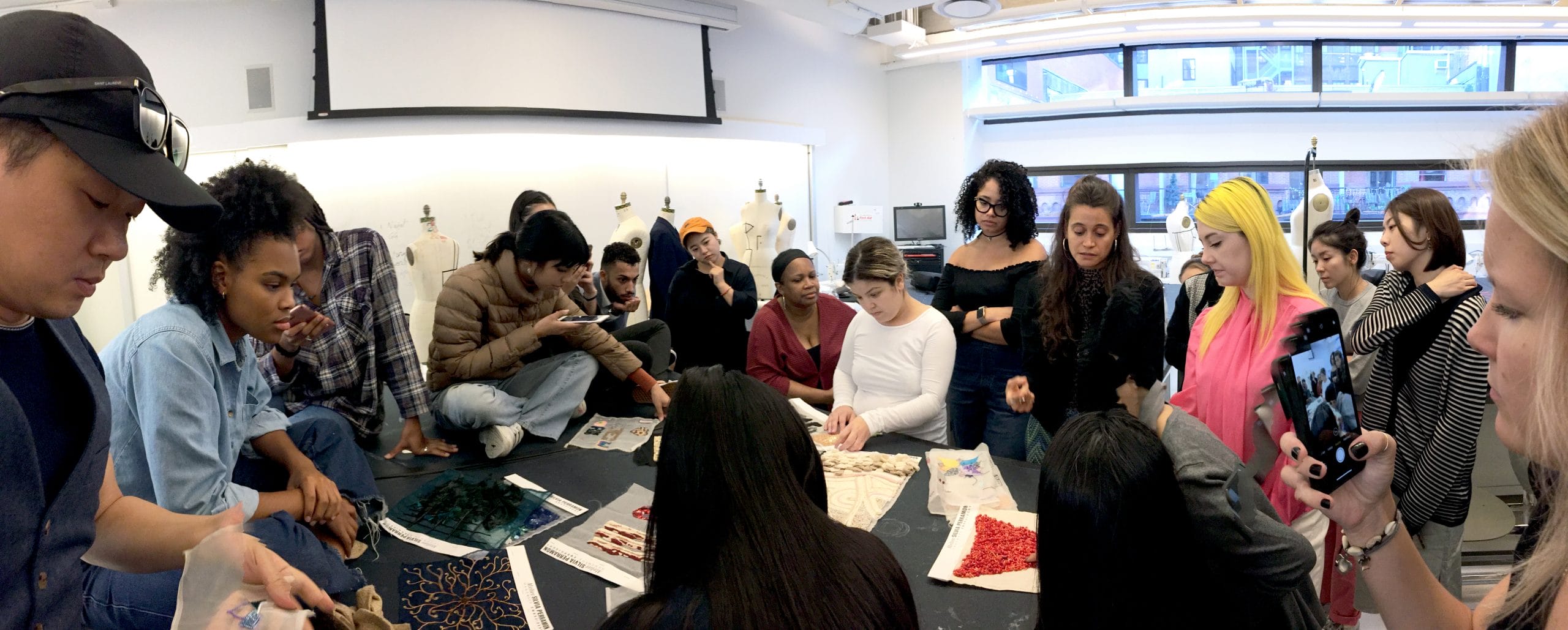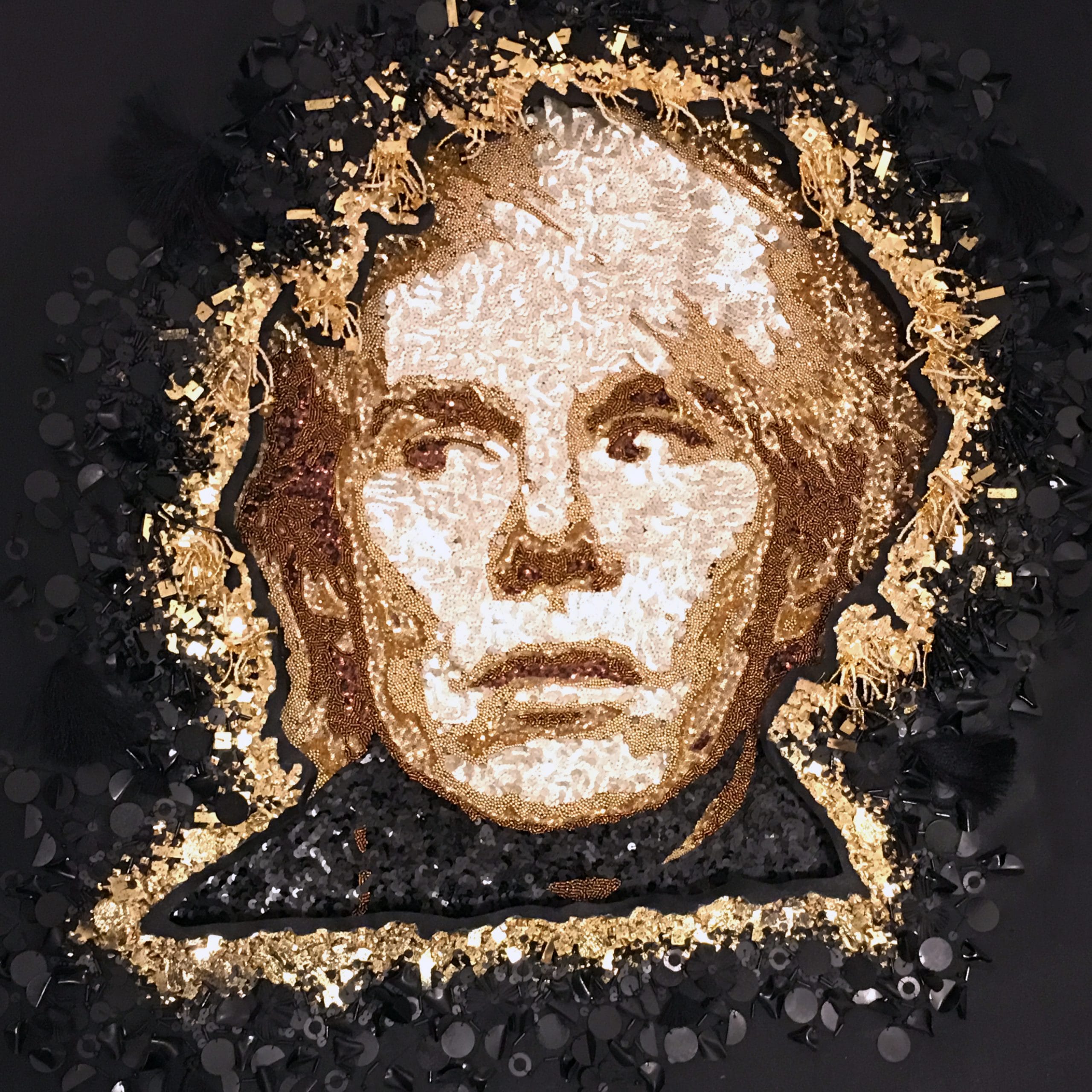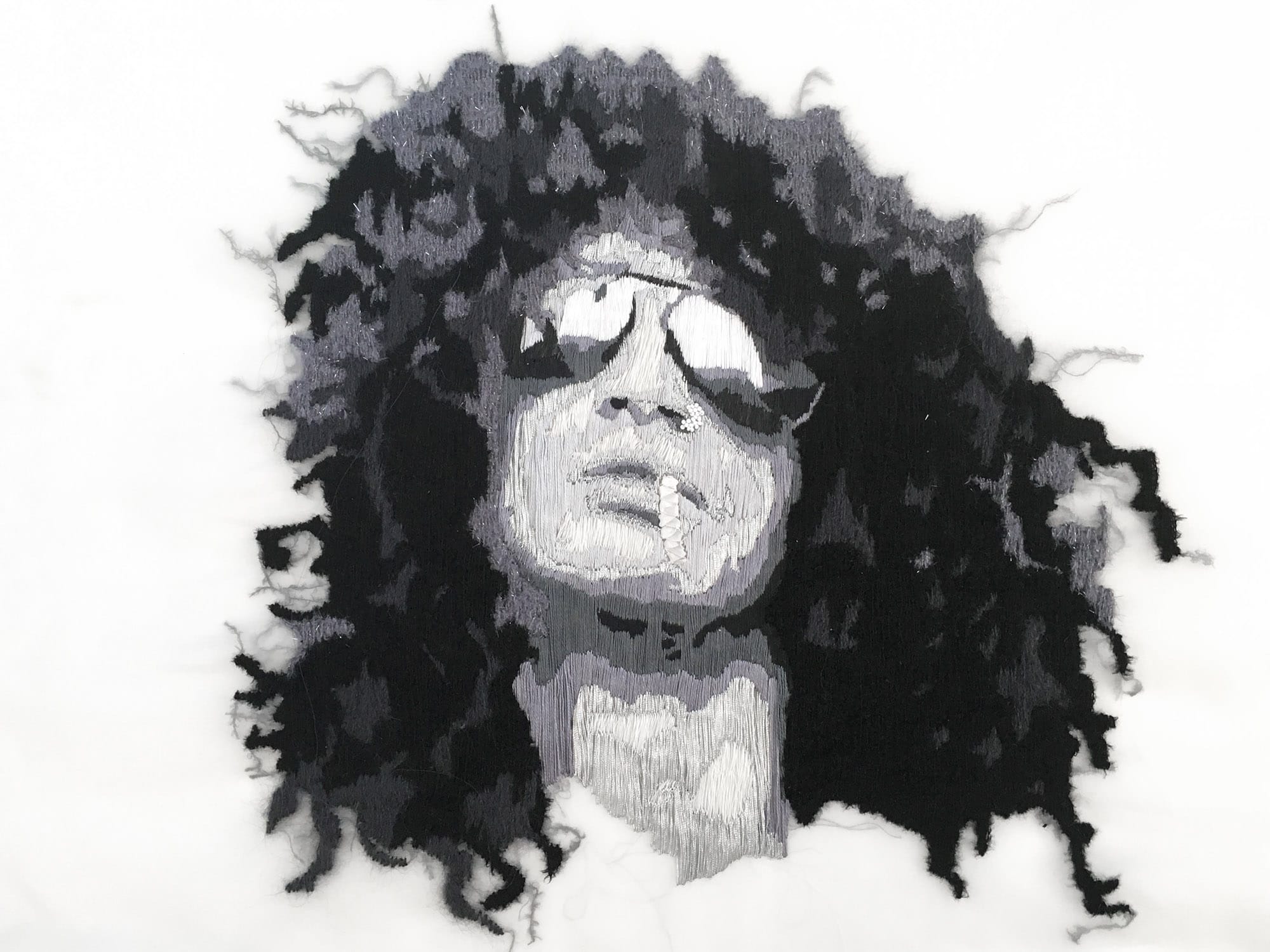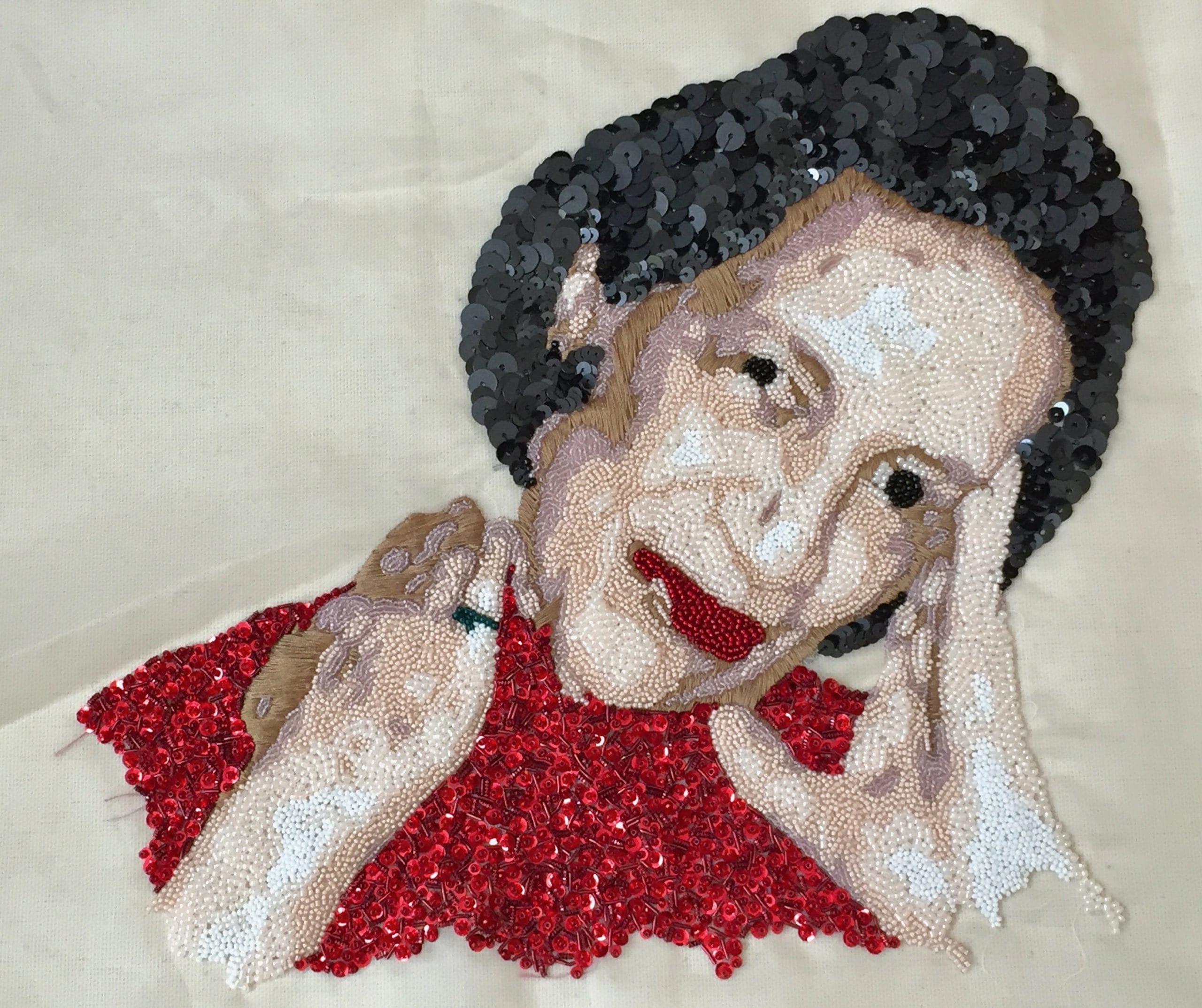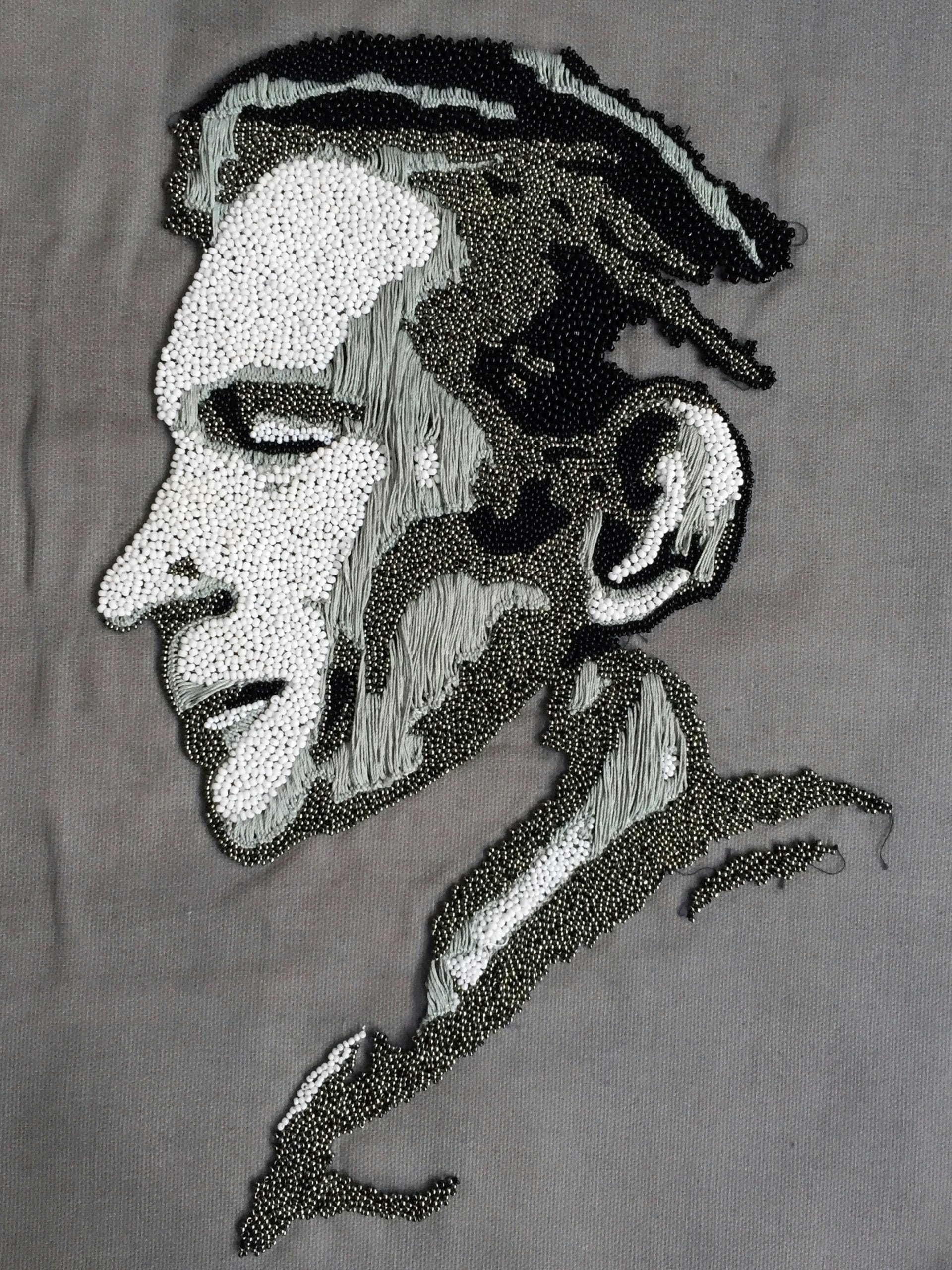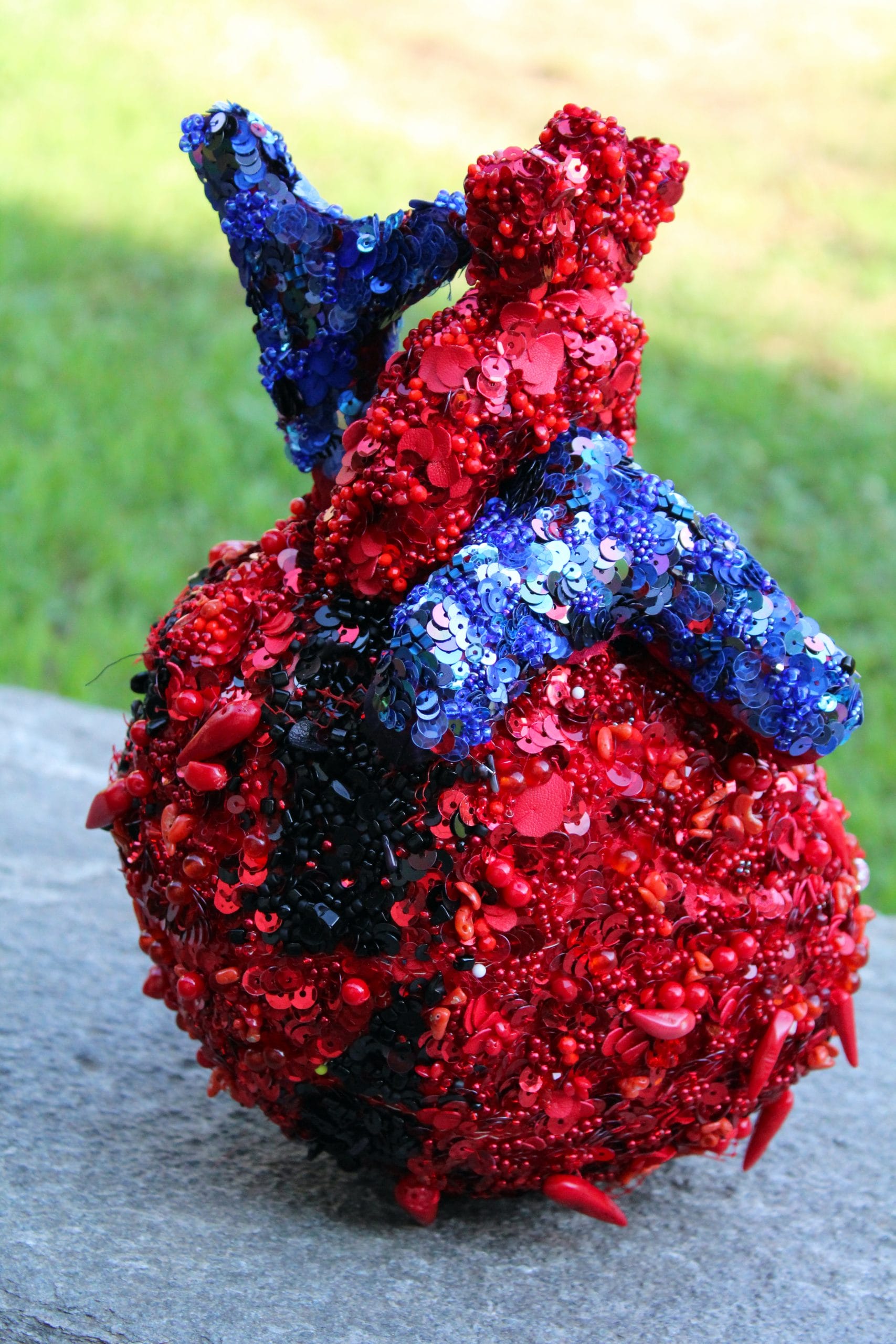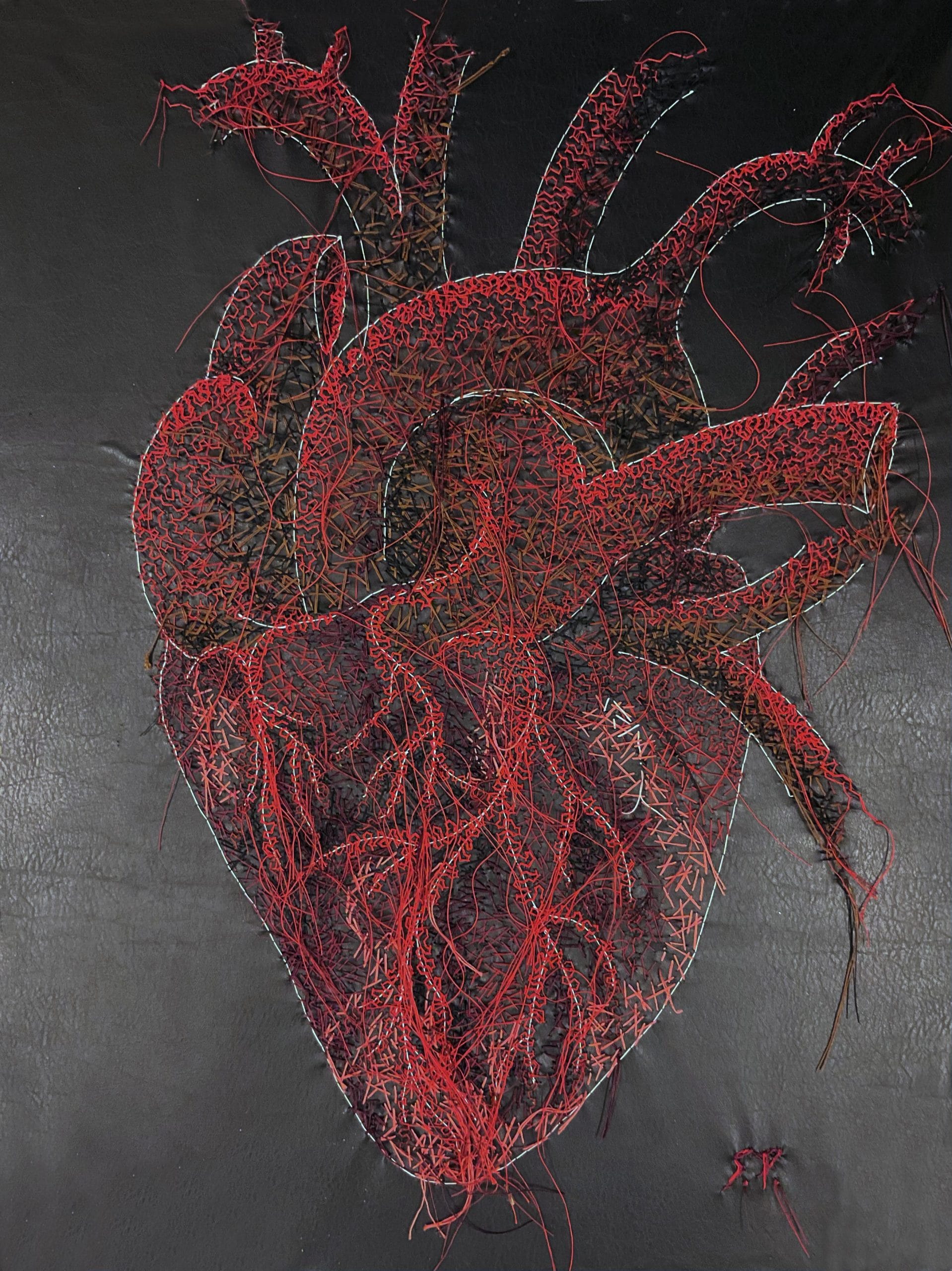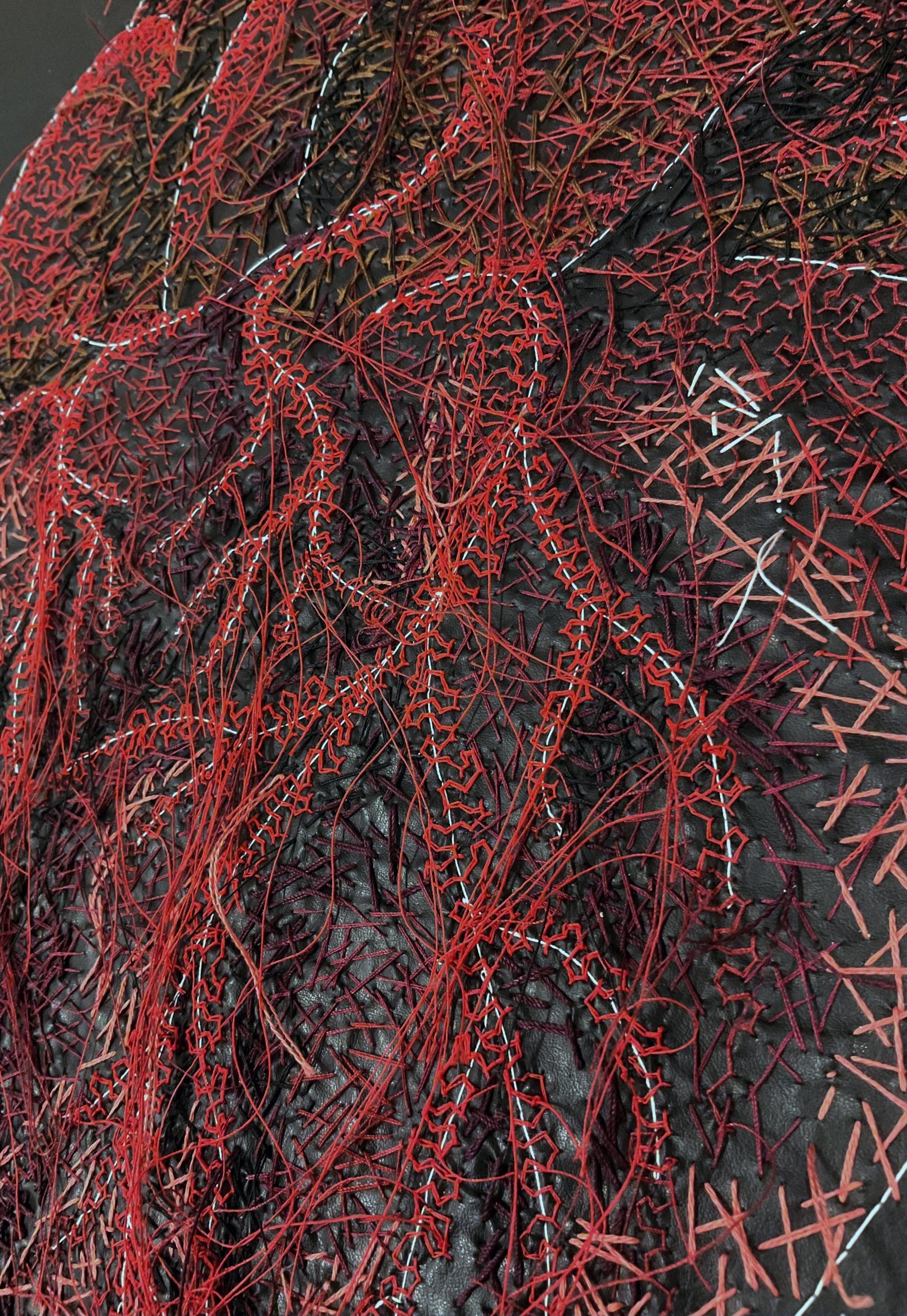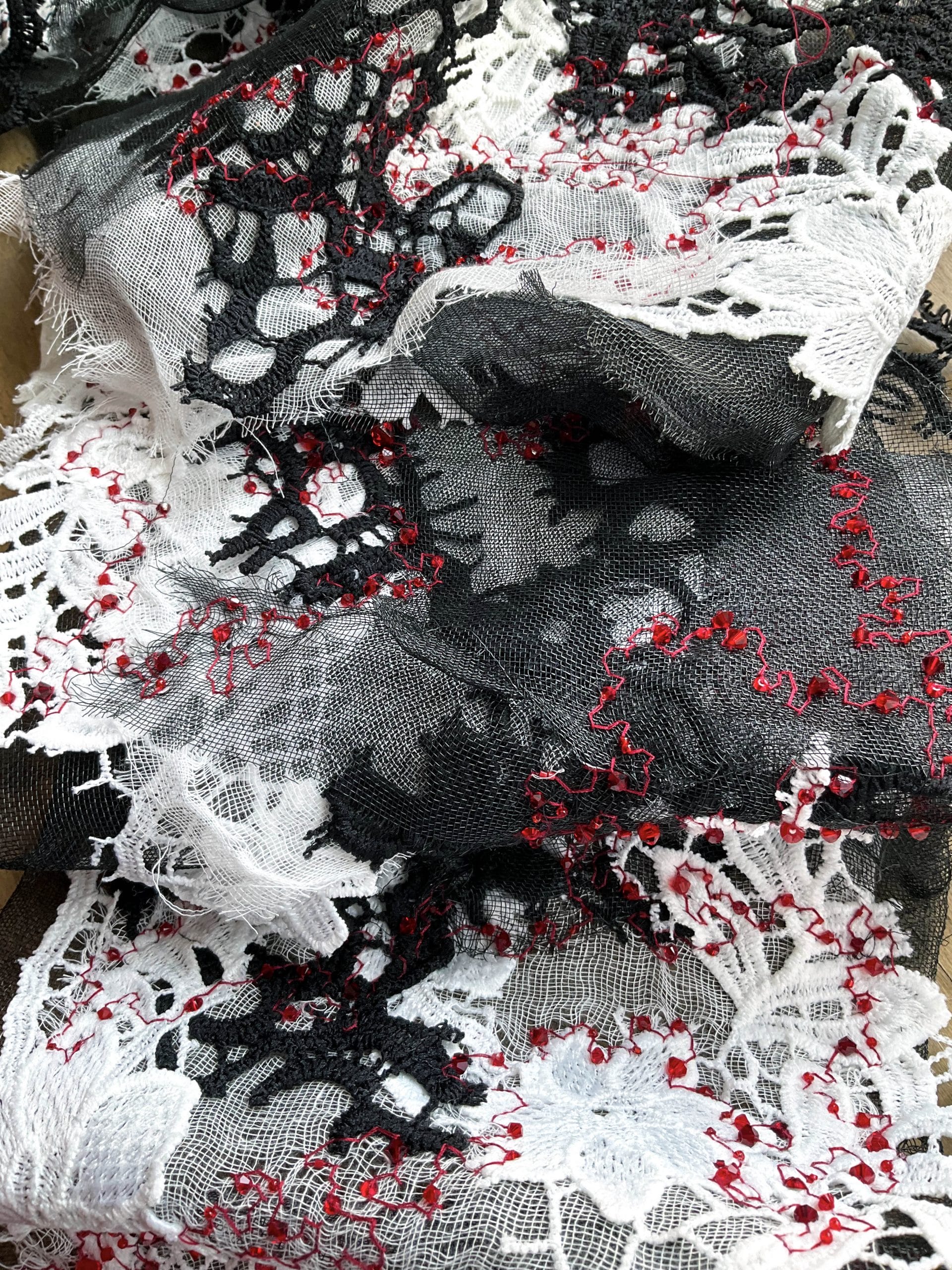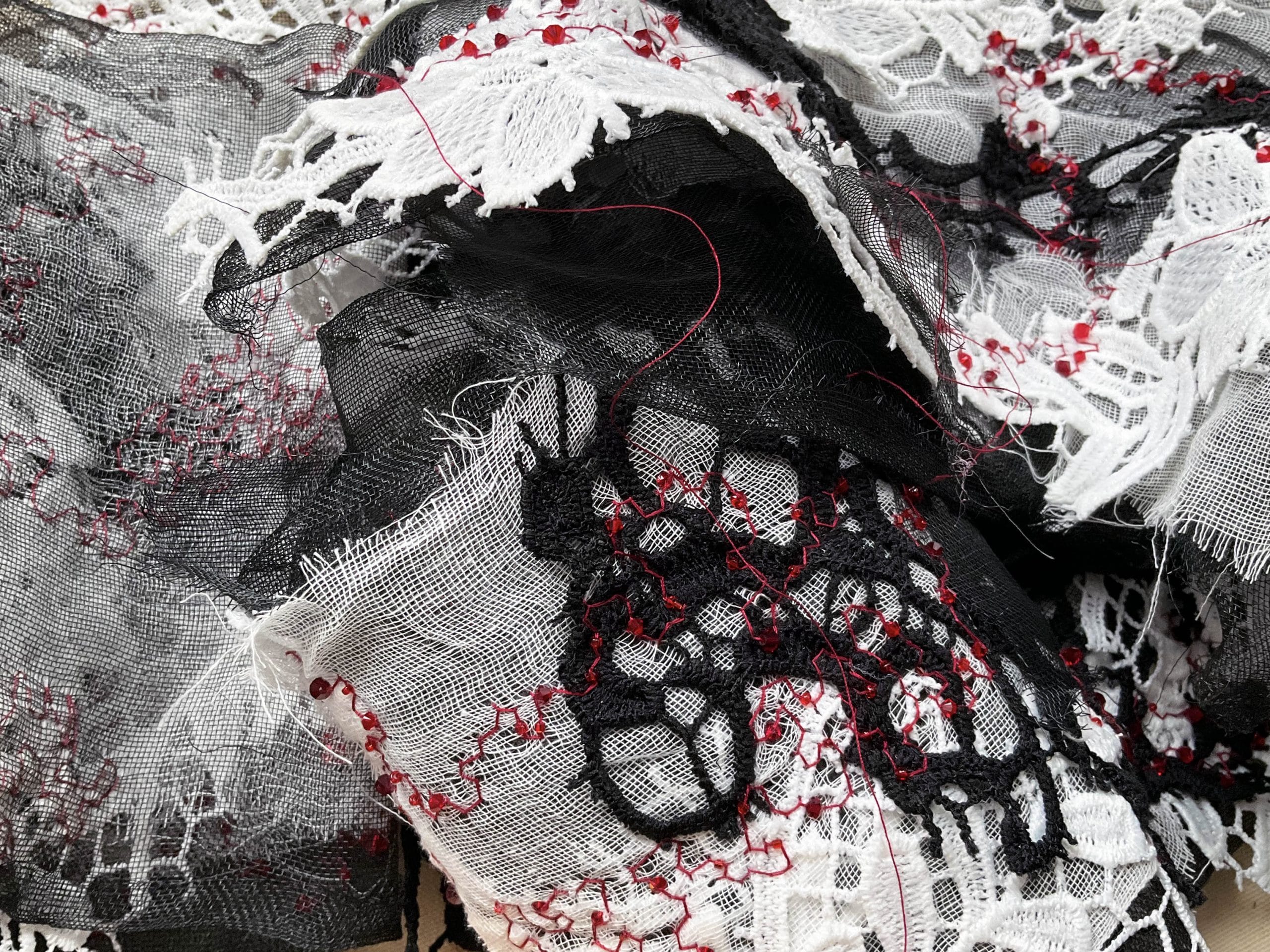Silvia Perramon, from haute couture to art through embroidery
Translation by Chiara Cordoni
An expert embroiderer for haute couture, Silvia Perramon found in embroidery first a prestigious profession, then an expressive medium that allowed her to go beyond the dimension of function to give shape to a research in the artistic field that ranges from autobiographical themes to instances of contemporary society.
Her portraits, full of shimmering embroidery, deal with the dichotomy between being and appearing, a crucial theme in an age of social media that translates images into content, form into substance, sometimes contributing to attributing the depth of myth to the ephemeral superficiality of the influencer phenomenon. Her experimentation has more recently led to informal works in which the focus is on illness and its psychological and social effects. Perramon’s approach is always poised between the visible and the invisible and oriented towards investigating not the plot but rather the warp and weft of phenomena and events, the hidden, ghostly, occult part: at the centre of her attention are the fundamental aspects of existence that almost never coincide with the flashy showcase that is displayed.
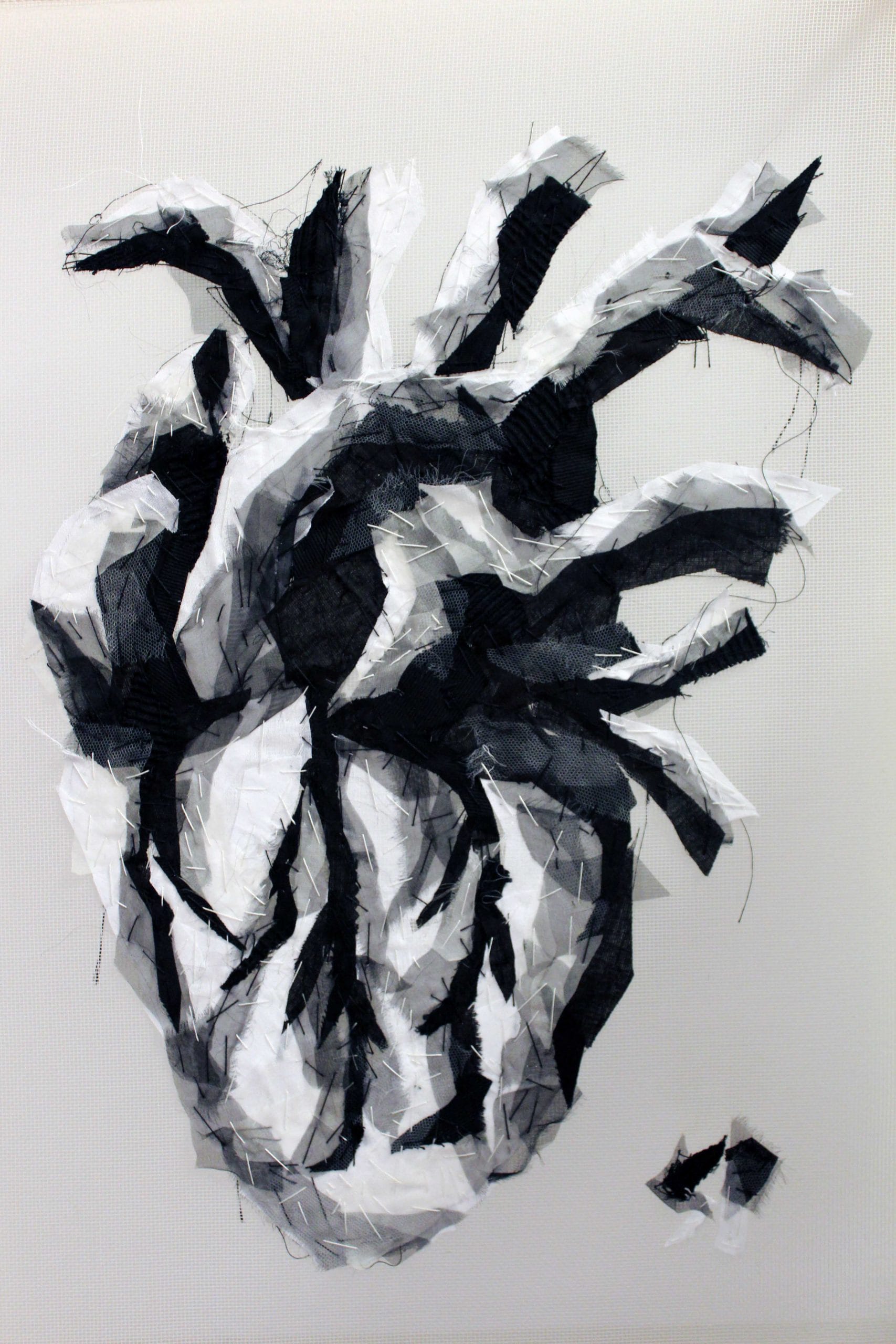
First architecture, then you met embroidery and it was ‘love at first sight’. What did it mean and what does embroidery mean to you?
I usually use the Lunèville technique, which I learned during a course in Kentucky, USA, with Professor Robert Heaven. I am fascinated by the idea that this very precise technique, with its millimetre-perfect control of the work, allows me to express a creative thought and let it grow as the number of stitches increases. Applying a technique that one deeply possesses, to the point of proceeding almost ‘automatically’, leaves my mind and hands free to create, to give shape to the idea and express it. I think that learning classical techniques is the necessary basis to be able to question and evolve them. As it happens with classical dance for a contemporary dancer or with the calculation of structures within the design process of an architectural work. Which are, by the way, the two disciplines I come from and in which I have trained and worked hard for.
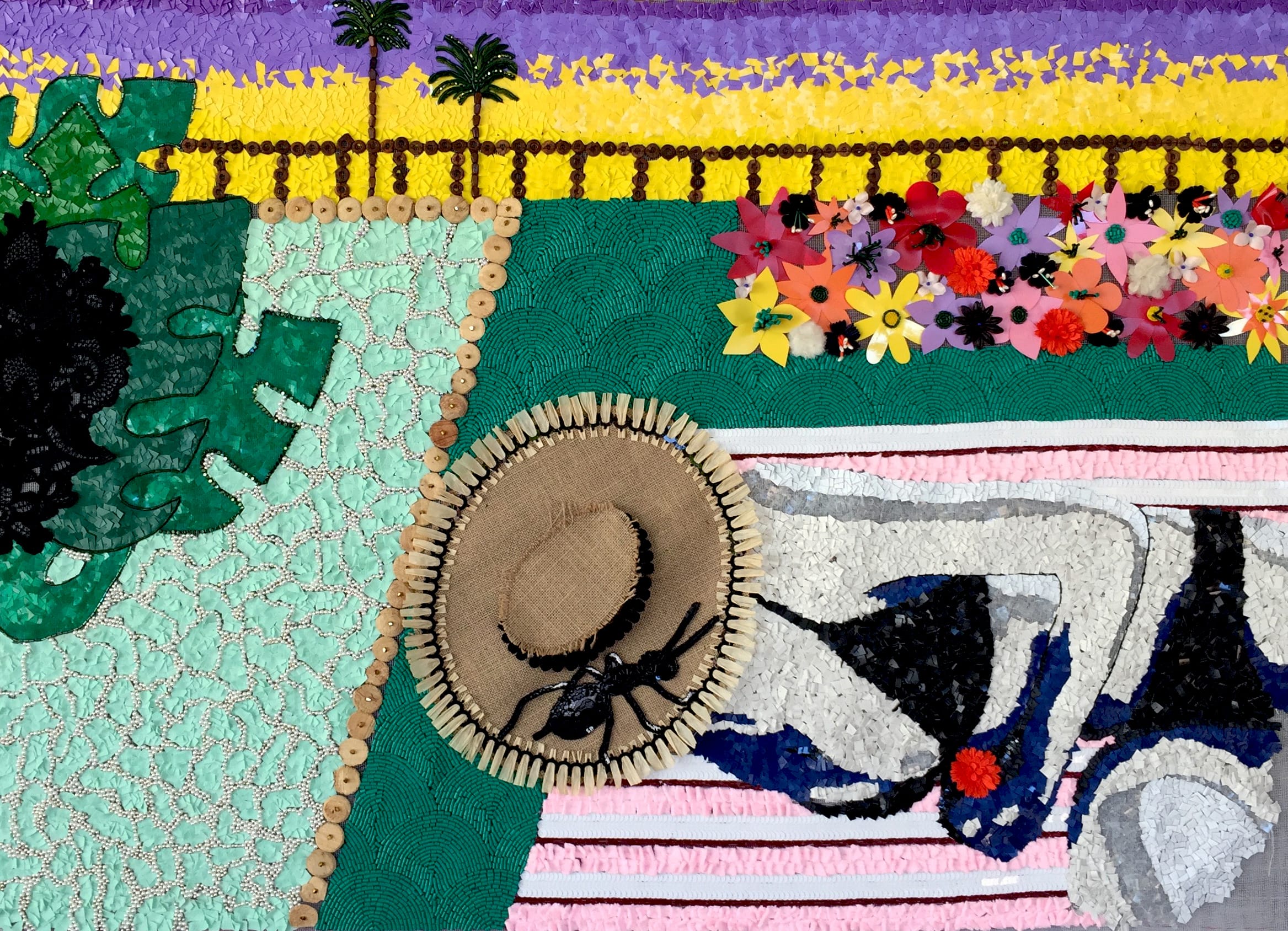
From the point of view of artistic research and experimentation, what do you think is the difference between your work in fashion and the artistic practice?
I entered the world of haute couture directly because I already had experience in hand embroidery. It wasn’t a decision but a set of coincidences. This type of technique is so popular in Haute Couture that I never needed to show my CV. Just by saying that I am an expert in the Lunèville technique, the doors of the ateliers of the best fashion houses in the world were opened to me, from when I started and lived in New York with brands such as Proenza Schouler and Coach, to now living in Milan, working with Dolce&Gabbana, Gianni Versace, Alyx Studio, The Attico, among others. I also had the opportunity to give lectures at the Parsons School of Design in New York for Couture classes and do demos of this technique for fashion students.
Embroidery in fashion is always a complement to an element, the garment. The first fundamental thing is that it is always a team effort: an idea must always be coordinated with the other departments and offices – pattern makers, designers, seamstresses – sometimes it must also be measured against the hyper-creative but always stimulating input of clients or celebrities, not to mention the confrontation with those who manage budgets. The second fundamental thing is that it must of course be functional embroidery, in terms of weight, consistency and above all adaptation to the shape of a body: if you embroider, you know perfectly well that you will never fill the armpit area, the inseam or the area above a zip with material!
In the artistic field, however, there are no limits. It is a way of expressing oneself, it is not a complement to anything, it may or may not make sense, it simply has to convey.
We often hear that some clothes are works of art. They require a lot of work, the result itself can perhaps end up being a masterpiece. But behind it is not an artist, but rather a team of professionals and craftsmen, the best in their field, who coordinate their knowledge to generate something perfect. It is like a motorway: it is perfect and functional, but it is the result of a set of calculations, projects and works that allow us to cross a country from one end to the other almost without thinking about what it would be like to drive through fields and forests, between lakes, mountains and the sea, but it is not a work of architectural art.
Your portraits, which the embroidery process transforms into glittering ‘icons’, are a series of works that seem to suggest that each of us ‘shines in its own light’, each of us is the protagonist of our own destiny, each of us has a part of the divine within us, or is it rather a reflection on the shimmering glow that all too often obscures the shadows of reality, all too often mythologizes inadequacy disguised as dazzling lights?
As human beings we have a tendency to idealize: gods, political leaders, famous people. It is like giving hope of a bright future through a being that is not the Ego. It is a hidden form of EGO, because we take responsibility for consequences away from ourselves: we believe we are so untouchable (or so perfect) that the fault (or the credit) is always someone else’s. It is true that we are social animals and we have to share, but each of us contributes something very important to society because we are unique and not replicable. We are the creation of our present actions. As the American artist Andrew Warhola, better known as Andy Warhol, predicted: “In the future, everyone will be world-famous for 15 minutes”. I chose faces of people who are connected to my disciplines – dance, architecture, art, fashion – and whose biographies I studied more deeply and realised that, as they say in Spanish: “No es oro todo lo que brilla“.
The heart is one of the recurring themes in your work. You represent a ‘physical’, almost real heart. What meaning does it have for you and what thoughts would you like it to stimulate in the viewer?
First and foremost, I would like those who ‘meet’ my hearts to have an independent thought, so as to create a direct connection with me. The heart is the purest form of feeling, there is no filter or connection.
Conceptually, mine is a reflection of how the physical health of the heart can affect our personality in the social sphere. My brother was born with a heart condition, so I know all the problems, especially the psychological ones, that one is forced to face when this vital organ does not work well.
One of my works/performances, which lasted for a year, consisted in giving people a copy of two small paintings with hearts painted in opposite complementary colors. This way I created a very deep connection directly with that person and, indeed, left a part of me with each of them. I made the same copy of each one for myself, writing the date and place where the intervention took place. It is a way of remembering the single moment, far from the daily routine that society forces us into.
My work ‘El Corazon’ is a sculpture of an imperfectly shaped heart, a tribute to all weak hearts, entirely covered in sequins to make it shine and come out of the dark.
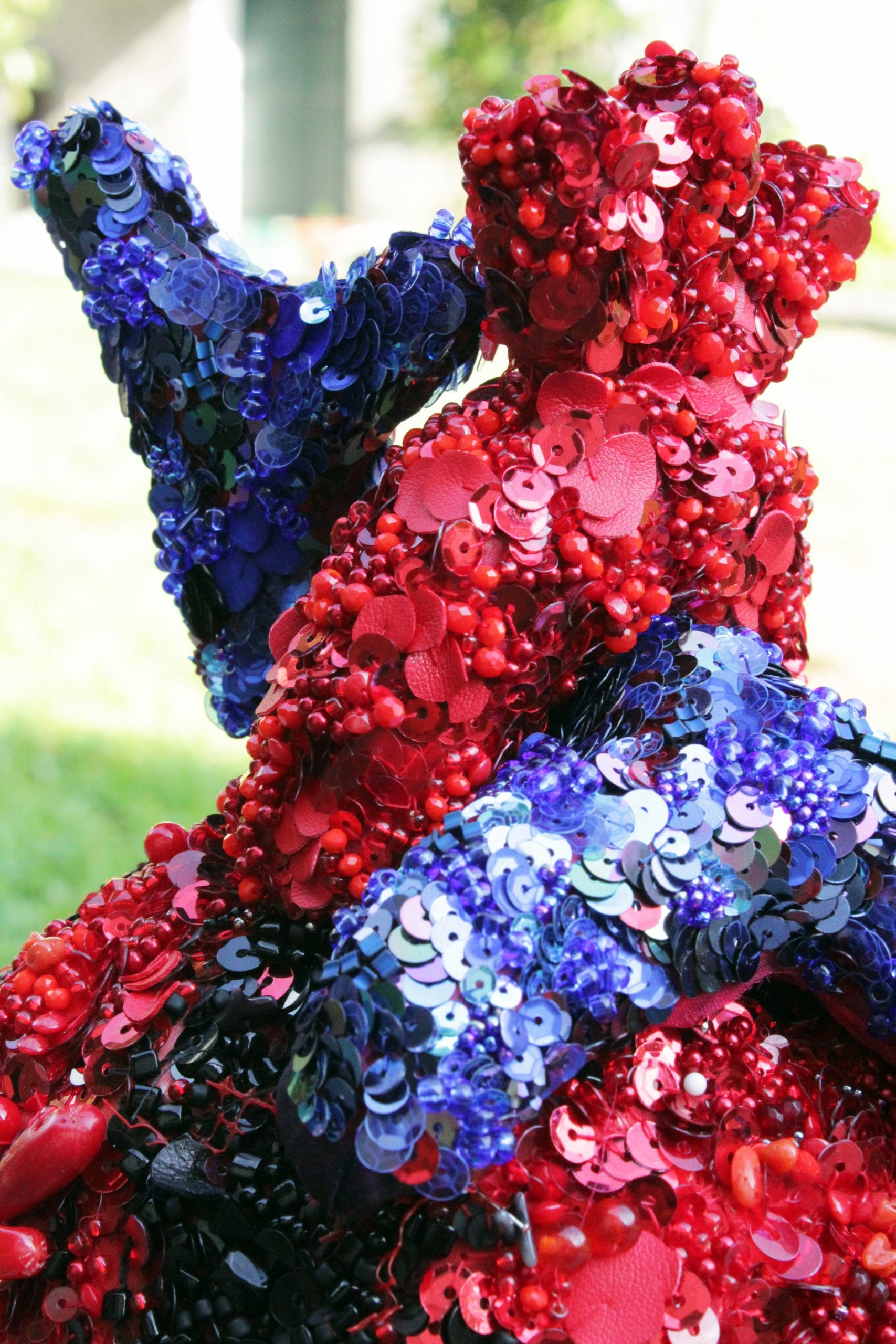
Some of your works are made with ‘ghost’ fragments of fabric that is used in fashion to make embroidery on a loom and that is then removed, unraveled. Can you tell me about these works that preserve the memory of a production process, of another story, before becoming art?
It is in fact a hidden process, like the mold of a sculpture. A very delicate moment, in which the embroiderer has to face the result, take the piece off the loom, and meticulously unravel with small scissors and tweezers what has been the base for hundreds of hours. These fabrics have an open weave, which means that it can be broken down by pulling each of the threads that form it.
Each time I proceed with this intervention, I see how the piece twists and takes on three-dimensional shapes: this effect inspired me to break out of the mythical two-dimensionality of embroidery and pushed me to experiment with embroidery of greater volume created by the action of the material and its structure, not like a fabric made into a sewing pattern that covers and adapts to a surface. The action of pulling the threads exists, but not to disappear, rather to remain and be part of the final work. These works connect my many universes: embroidery, fashion and art. No longer part of a story but a story themselves – no longer a functional element but a technique that allows me to express myself in a more sculptural way. They are conceptual and abstract pieces that do not follow any form or aesthetic but in which the material is the expressive medium of a concept that has already been elaborated and evoked and conveyed by it.
What project are you working on at the moment? And after the group exhibition at Palazzo Velli in Rome, what are your next exhibitions?
The world of haute couture is an ongoing commitment: I work for large fashion houses that create for private clients, celebrities and for international fashion shows which means that even when it is not catwalk time there are always events or clients who need unique garments to be created or modified.
I collaborate with Indian embroidery companies for whom I am a trait d’union with Italian brands to develop ideas for embroidered collections.
As an artist I always have a desire to escape the perfection that embroidery for fashion rightly requires. I am currently working on one of the abstract pieces with ‘ghost’ fabrics around the concept of the heartbeat, a phenomenon that is absolutely real and not visible to the naked eye, almost ghostly, but inextricably linked to electricity of the body.
In December, two exhibitions were held in Milan: “SPOT” a two-person exhibition with Simona Uberto, artist and teacher at the Brera Academy of Fine Arts, at the Gli Eroici Furori gallery, and the solo show “HeartBeat” at Pier Giuseppe Moroni’s 7.24×0.26 gallery.
The embroidery artist Silvia Perramon was born in 1988 in Madrid, Spain. After graduating from Architectural School in Barcelona, in 2012, she studied Hand Embroidery at Bead Embroidery and Design Studio in Kentucky, USA, in 2014, and later at Scuola di Ricamo Alta Moda in Rome, in 2017. In addition, she has full education on Classical Ballet, trained by Royal Academy of Dance, London.
Silvia has lived in Hanzhou, China, for her early architectural work; in Bombay, India, to deepen her embroidery skills and then in New York, USA, applying her knowledge to the fashion field, collaborating with brands like Proenza Schouler NYC with whom she made special projects and runways in New York and Paris.
Since 2017 she is based in Milano, Italy, where she collaborate and consult for fashion brands and independent designers as an embroidery designer and hand embroiderer. She is often invited at Parsons School of Design in New York City as a guest teacher for the couture classes, and twice a year she teaches Hand Embroidery in New York in private workshops.
In 2018 she won the World Prize for Embroidery Art issued by the Hand and Lock Prize in London UK. Since 2020 she is also a member of the S.E.W. Society of Embroidery Works in England.

